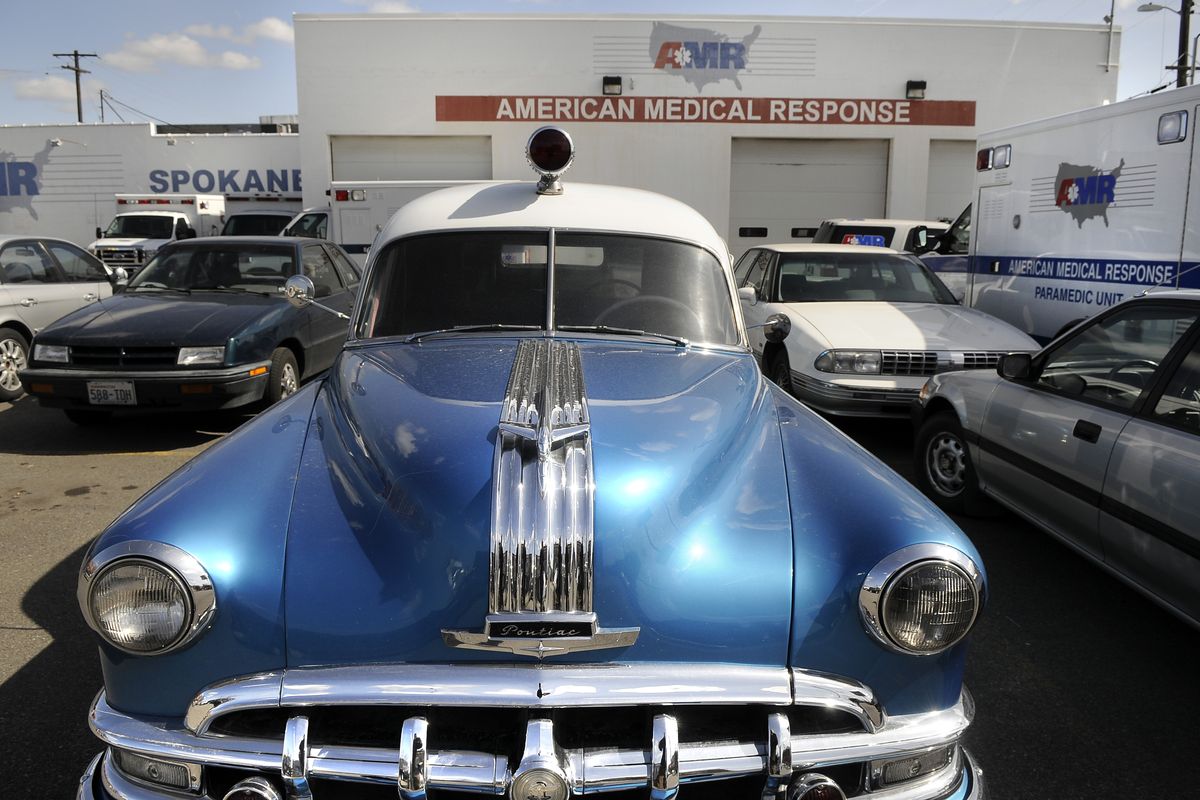Shared Spokane County ambulance system on hold
Rate concerns, lack of trust hinder plan for joint contract
A 1950 Pontiac ambulance adorns the parking lot at the American Medical Response headquarters at the corner of Monroe Street and Sharp Avenue in Spokane. (Dan Pelle)
Hopes for creating one ambulance system throughout most of Spokane County are fading after city and Spokane Valley fire leaders opted against the concept.
Fire officials created the Ambulance Service Board to consider building an ambulance system that would have the same rates and similar response-time requirements throughout the county.
Supporters argued that one contract would lower ambulance bills and create leverage to improve service. Those on the Spokane City Council were less excited about the idea, largely because the city already enjoys low ambulance bills. Even so, council members agreed to join the Ambulance Service Board to explore the concept.
This week, however, the council voted 4-3 to end its board membership at the end of the month. One concern cited by some on the council was that the city only had one seat on the board.
“We’re really not getting fair representation,” said Councilman Bob Apple.
Not that the city’s decision mattered much. Last week, the Spokane Valley Fire Commission voted unanimously to negotiate a regional ambulance contract with American Medical Response without city participation.
“I just don’t think we can trust them,” Valley Fire Commissioner Monte Nesbitt said at last week’s meeting. “I think we should just do it ourselves.”
An advanced life support ambulance ride in the city of Spokane costs $568. Within the Spokane Valley Fire District and most other places in Spokane County, that ride averages $952. The city and most Spokane County fire districts are served by American Medical Response.
AMR was the only ambulance company that bid on a countywide contract last year when the ambulance board solicited responses. One option in AMR’s bid suggested that in 2014 the advanced life support rate could have been $838 throughout the city and county.
The city logs about 15,000 ambulance rides a year; elsewhere in the county there are about 10,000.
Spokane Fire Lt. Mark Vietzke, president of the Spokane Firefighters Association, said that in a countywide system, city ambulance users would pay more to make up for the higher costs of serving rural areas.
“We didn’t want to see any rates for the city to go up to help subsidize the rates for people living in the county,” said Vietzke, who praised the City Council’s decision.
Spokane Fire Chief Bobby Williams said just because the city’s rate is lower than a countywide rate now doesn’t mean that will be the case when the city’s contract expires in 2013.
“Everything we’re getting told is that the contract rate is going to go up significantly,” Williams said. “What we were trying to do is minimize the increase to our citizens as well as get in place protections for the rest of Spokane County.”
Nesbitt, of the Spokane Valley Fire Commission, said in an interview that the district’s distrust of the city of Spokane dates back more than 15 years to when a regional communications center was created and administered by the city. At the time, Spokane County fire districts were asked to pay a higher dispatch rate with the promise that rates would equalize over time, Nesbitt said.
Regular pleas to lower the rate have been brushed aside, Nesbitt said. “It just keeps going up,” he said.
Spokane pays $39 per call that results in a fire agency being dispatched. Other areas, including within the Spokane Valley Fire District, pay $78 per call.
Williams said the city pays less for each call to offset costs the city incurred to build the system. He said he remembers no promises ever made by the city to equalize fees. Instead, he said, the city agreed that fees would increase over time at the same rate.
“We had put millions of dollars into the system and the building that became the combined communications operation,” Williams said.
Considering a regional system, Nesbitt said the Valley fire board was concerned about a proposal for the city to oversee the ambulance contract and collect about $600,000 to do so. He said the Valley department could administer the contract for about $100,000.
“Holy mackerel,” he said. “What are you going to do with $600,000?”
But Williams said the proposed $600,000 fee was only about $125,000 more than what the city currently collects from AMR for its city-only contract. AMR gives the city a $342,000 administration fee and pays about $120,000 a year more in fees for not meeting response-time requirements stipulated in the city’s contract.
Some City Council members argued that there was no harm to continue working with the ambulance board.
“There’s been a lot of time and energy and work and good faith,” said Councilwoman Nancy McLaughlin. “I feel like we’re cutting it short.”
But others said that given the price difference between a regional contract and a city-only contract, further negotiations would not have resulted in a better deal.
“I can’t in good conscience move forward if we’re just delaying the inevitable,” City Councilwoman Amber Waldref said.
Nesbitt said he wasn’t upset when the city withdrew from negotiations.
“We won’t miss them,” he said. “This has drug on for four years because of them.”

